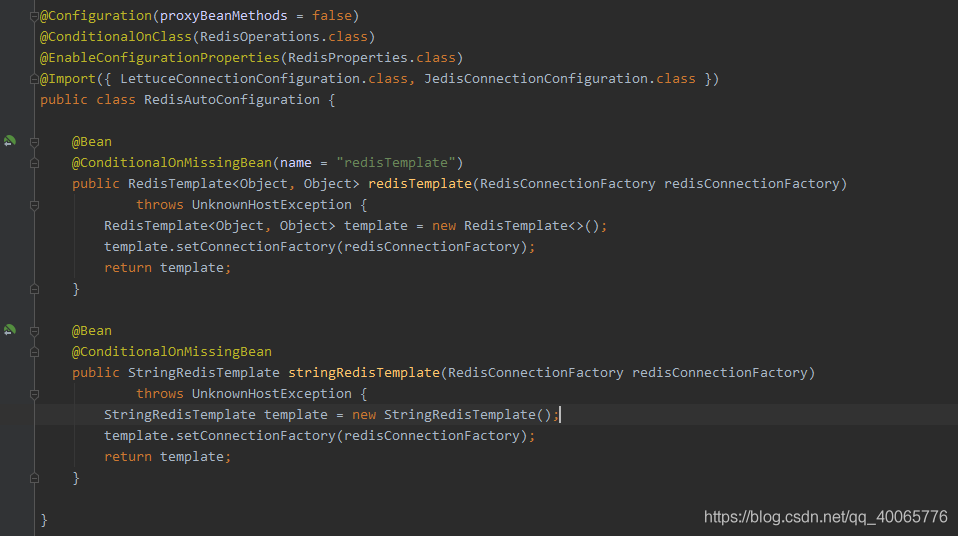◎欢迎参与讨论,请在这里发表您的看法、交流您的观点。
SpringBoot整合Redis实现序列化存储Java对象的操作方法
ID:987 / 打印哈喽!大家好,很高兴又见面了,我是24分享网的一名作者,今天由我给大家带来一篇《SpringBoot整合Redis实现序列化存储Java对象的操作方法》,本文主要会讲到存储、序列化、SpringBootRedis等等知识点,希望大家一起学习进步,也欢迎大家关注、点赞、收藏、转发! 下面就一起来看看吧!
之前介绍过 https://www.jb51.net/article/223539.htm 我们可以看出,在 SpringBoot 对 Redis 做了一系列的自动装配,使用还是非常方便的
一、背景
1、思考
通过我们前面的学习,我们已经可以往 Redis 中存入字符串,那么我们要往 Redis 中存入 Java 对象该怎么办呢?
2、方案
我们可以将 Java 对象转化为 JSON 对象,然后转为 JSON 字符串,存入 Redis,那么我们从 Redis 中取出该数据的时候,我们也只能取出字符串,并转为 Java 对象,这一系列的操作是不是显得有些麻烦呢?
二、源码分析

- 以上是 RedisAutoConfiguration 类中的源码片段,可以看出 SpringBoot 对 Redis 做自动化配置的时候,在容器中注入了 redisTemplate 和 stringRedisTemplate
- 其中,RedisTemplate
- 看到这个@ConditionalOnMissingBean注解后,就知道如果Spring容器中有了RedisTemplate对象了,这个自动配置的RedisTemplate不会实例化。因此我们可以直接自己写个配置类,配置RedisTemplate。
三、注入RedisTemplate
1、引入依赖
org.springframework.boot spring-boot-starter-data-redis
以上引入了 redis 的依赖,其余依赖请自行添加
2、Redis 连接信息
spring: # Redis配置 redis: host: 127.0.0.1 port: 6379 database: 10 jedis: pool: # 连接池最大连接数(使用负值表示没有限制) max-active: 50 # 连接池最大阻塞等待时间(使用负值表示没有限制) max-wait: 3000ms # 连接池中的最大空闲连接数 max-idle: 20 # 连接池中的最小空闲连接数 min-idle: 5 # 连接超时时间(毫秒) timeout: 5000ms
3、Redis 核心配置类
Redis 的核心配置我们放在 RedisConfig.java 文件中
package com.zyxx.redistest.common; import com.fasterxml.jackson.annotation.JsonAutoDetect; import com.fasterxml.jackson.annotation.PropertyAccessor; import com.fasterxml.jackson.databind.ObjectMapper; import org.springframework.context.annotation.Bean; import org.springframework.context.annotation.Configuration; import org.springframework.data.redis.core.RedisTemplate; import org.springframework.data.redis.serializer.Jackson2JsonRedisSerializer; import org.springframework.data.redis.serializer.RedisSerializer; import org.springframework.data.redis.serializer.StringRedisSerializer; /** * @ClassName RedisConfig * @Description * @Author Lizhou * @Date 2020-10-22 9:48:48 **/ @Configuration public class RedisConfig { /** * RedisTemplate配置 */ @Bean public RedisTemplate 我们注入了一个名称为 redisTemplate,类型为 RedisTemplate
4、Redis工具类
我们将对 Redis 进行的一系列操作放在 RedisUtils.java 文件中
package com.zyxx.redistest.common; import lombok.extern.slf4j.Slf4j; import org.apache.commons.lang3.StringUtils; import org.springframework.beans.factory.annotation.Autowired; import org.springframework.data.redis.core.RedisTemplate; import org.springframework.stereotype.Component; /** * @ClassName RedisUtils * @Description * @Author Lizhou * @Date 2020-10-22 10:10:10 **/ @Slf4j @Component public class RedisUtils { @Autowired private RedisTemplate redisTemplate; /** * 根据key读取数据 */ public Object get(final String key) { if (StringUtils.isBlank(key)) { return null; } try { return redisTemplate.opsForValue().get(key); } catch (Exception e) { e.printStackTrace(); } return null; } /** * 写入数据 */ public boolean set(final String key, Object value) { if (StringUtils.isBlank(key)) { return false; } try { redisTemplate.opsForValue().set(key, value); log.info("存入redis成功,key:{},value:{}", key, value); return true; } catch (Exception e) { log.error("存入redis失败,key:{},value:{}", key, value); e.printStackTrace(); } return false; } } 我们写入了 get,set 两个方法用于测试
四、测试
1、创建 Java 实体类 UserInfo
package com.zyxx.redistest.common; import lombok.Data; import java.io.Serializable; import java.util.Date; /** * @ClassName UserInfo * @Description * @Author Lizhou * @Date 2020-10-22 10:12:12 **/ @Data public class UserInfo implements Serializable { /** * id */ private Integer id; /** * 姓名 */ private String name; /** * 创建时间 */ private Date createTime; } 2、测试用例
package com.zyxx.redistest; import com.zyxx.redistest.common.RedisUtils; import com.zyxx.redistest.common.UserInfo; import org.junit.jupiter.api.Test; import org.springframework.beans.factory.annotation.Autowired; import org.springframework.boot.test.context.SpringBootTest; import java.util.Date; @SpringBootTest class RedisTestApplicationTests { @Autowired private RedisUtils redisUtil; @Test void contextLoads() { UserInfo userInfo = new UserInfo(); userInfo.setId(1); userInfo.setName("jack"); userInfo.setCreateTime(new Date()); // 放入redis redisUtil.set("user", userInfo); // 从redis中获取 System.out.println("获取到数据:" + redisUtil.get("user")); } } 我们向 Redis 中存入了一个 key 为 ”user“,value 为 UserInfo 对象的数据,然后再根据 key 获取该数据
3、测试结果

可以看出,我们往 Redis 中成功存入 Java 对象数据,并成功获取到了该对象
今天关于《SpringBoot整合Redis实现序列化存储Java对象的操作方法》的内容就介绍到这里了,是不是学起来一目了然!想要了解更多关于redis的内容请关注the24.cn!
